Main results from the publication "Participation in adult education and training in Finland. Adult Education Survey 2000"
Adult Education Survey 2000 is the fourth survey made by Statistics Finland on participation in adult education and training. The previous adult education surveys were from 1980, 1990 and 1995. The surveys were carried out jointly with the Ministry of Education.
The population of the Adult Education Survey 2000 are permanent residents of Finland aged between 18 and 79. A total of 5,000 persons were selected by systematic sampling. The total number of interviews was 3,602 and the response rate was 74 per cent.
- Participation in adult education and training increased
- One half of the labour force studied in connection with their work or occupation
- Adults also undertook self-directed studies
- Over half of the adults needed further training
- Three fourths of the adult population had used a computer
- Four fifths of the adults claimed knowledge of a foreign language
- About 12% of the population aged 65-79 years participated in adult education
Participation in adult education and training increased
The rate of participation in adult education and training by persons aged 18-64 years in 2000 was 54%. This represents almost a doubling of the rate within 20 years and a growth of about 6 percentage points since 1995.
Women were more active in this respect than men and their activity did not decline with age in the same way. The peak participation rate for women occurred in the age range 35-54 years and that for men at 25-34 years. Participation was highest in the urban areas.
Participation in adult education and training by age and gender in 2000 (population aged 18-64)
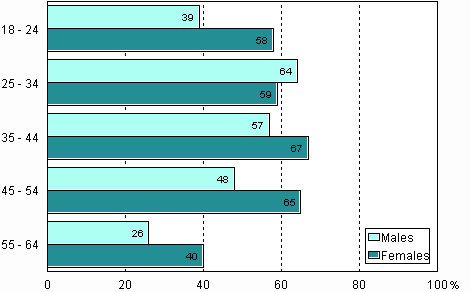
Participation in adult education and training was closely dependent on the level of educational attainment, in that the higher the level of education that a person possessed, the greater the likelihood of participation in adult education and training. Analysis in terms of socio-economic group similarly showed those in higher positions at work to participate in adult education and training the most. The differences between the groups representing level of basic education and socio-economic group were more pronounced among the men.
Participation in adult education and training by socio-economic group and gender in 2000 (population aged 18-64)
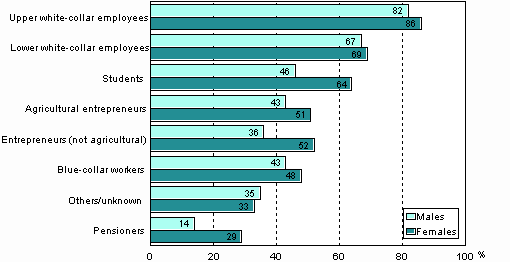
The adults who were at work took part in adult education and training more frequently than those who were unemployed or outside the labour force, 63% having done so in the previous year as compared with 37% and 36%, respectively.
Participation in adult education and training by labour market situation and gender in 2000 (population aged 18-64)
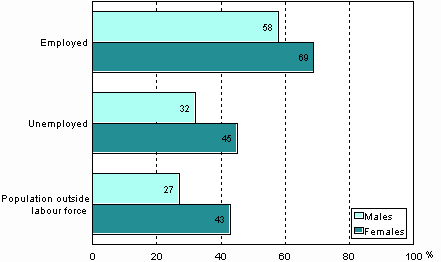
Participation in adult education and training was affected most by socio-economic group, secondly by level of education and thirdly by employment status.
The increase in participation in adult education and training was also reflected in the number of days of attendance during the year. Where the figure in 1990 had been about nine days per head of population aged 18-64 years, it had risen to 11 days in 1995 and to 13 days by 2000.
The women recorded more days of adult education and training per year than the men, and those with a high level of educational attainment more than those with a low level. On the other hand, the unemployed achieved twice as many days of attendance as the working population.
Nearly one fifth of the adults took part in adult education out of general interest or because of their hobbies
Over half a million people aged 18-64 years in Finland, or 18% of that sector of the population, 24% of the women and 12% of the men, took part in adult education and training out of general interest or because of their hobbies or pastimes during the year in question. These proportions have remained more or less constant since 1980. The main subjects studied for such purposes were fine and applied arts, physical education and foreign languages, and the main places of study were the local adult education centres or institutes.
One half of the labour force studied in connection with their work or occupation
Participation in adult education and training connected with one's work or occupation was nevertheless much more common, involving practically a half of the labour force during the year 2000.
The majority of those who had taken part in adult education and training for their work or occupation had received support from their employer, i.e. this could be regarded as employer-sponsored training. This involved 56% of the employees in the year in question, with participation again being affected by the person's socio-economic group and basic education, although also by the size of the establishment at which he/she worked. The larger the company, the greater the proportion of its employees received employer-sponsored training.
The number of days of employer-sponsored training per employee had risen markedly between 1995 and 2000, from 5 to almost 7.
Number of employer-sponsored training days per employee in 1990-2000 (employees aged 18 - 64)
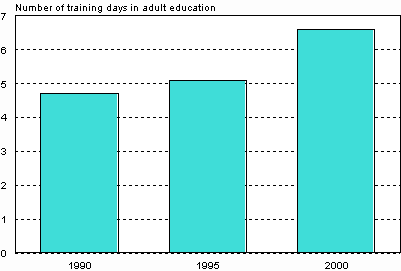
Adults also undertook self-directed studies
One in five of the population aged 18-64 years had studied independently, outside the formal education system, for at least 20 hours during the year, the young people, those with a high level of educational attainment and those of high socio-economic group doing so to a greater than average extent. The content of this study was mostly information technology.
Self-directed studies by highest level of educational attainment and gender in 2000 (population aged 18 - 64, excl. students)
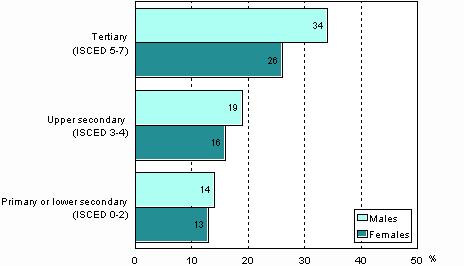
Over half of the adults needed further training
Over a half of the respondents aged 18-64 years indicated that they needed adult education and training of a kind that would enhance their professional skills and advance their career. This applied particularly to training in information technology, which was mentioned as necessary by 27%. Instruction in languages and business economics were mentioned the next often. Every second respondent indicated an intention to participate in training during the coming year, this being greatly influenced by the perceived need for training and participation during the preceding year.
Need for adult education in order to develop professional skills or advance one's career by content of education (population aged 18-64 years, excl. pensioners and students with no working experience).
| Content of studies | % |
| Use of information technology | 27 |
| Foreign languages | 14 |
| Business, marketing and administration | 12 |
| Management skills | 9 |
| Technology, production, construction, product development | 9 |
| Health care | 8 |
| Services, work safety, security, fire and rescue services and military services | 6 |
| Law, social sciences and behavioural sciences | 5 |
| Other subjects, total | 18 |
N.B. The same person may have indicated a need in more than one content area.
Awkward working hours and pressure of work were often barriers to participation
The most common obstacles preventing or interfering with adult education and training at the person's own expense in his or her leisure time were tiredness and financial considerations, although the most powerful individual barriers arose in the form of awkward or irregular working hours. Likewise, a major barrier to employer-sponsored training arranged by the employer in working time was felt to be pressure of work.
Opportunities at work to apply the knowledge learned and solve problems together
The majority of those who were at work felt that they had plenty of opportunities to use the new knowledge and skills that they had learned and to develop their own abilities and professional competence. Only 14% were of the opinion that they needed more training in order to cope with their work properly. Most people had resolved problems with the help of their colleagues and experts on hand at their place of work, but a half of those who had encountered problems had also resorted to outside experts, further training or the professional literature.
Three fourths of the adult population had used a computer
It was found that 69% of the population aged 18-64 years had used a computer within the last year and a half within the last two days. Altogether 74% had used one at some time, at work, at home or elsewhere.
Frequency of computer use by gender (population aged 18-64)
| Males | Females | Total | |||
| % | % | % | N | ||
| Have used the computer | 72 | 75 | 74 | 2,405,000 | |
| during the last | |||||
| - two days | 52 | 47 | 50 | 1,621,000 | |
| - week | 62 | 61 | 62 | 2,011,000 | |
| - six months | 67 | 68 | 68 | 2,207,000 | |
| - 12 months | 68 | 70 | 69 | 2,254,000 | |
| Have not used the computer | 28 | 25 | 26 | 856,000 | |
| Total | 100 | 100 | 100 | 3,261,000 | |
The young people, those with a high level of basic education, the white-collar employees and the students made the most use of computers, most frequently for text editing, although almost as often for searching information from the information networks and for communicating by e-mail.
Use of a computer within the last year by age and highest level of educational attainment (population aged 18 - 64)
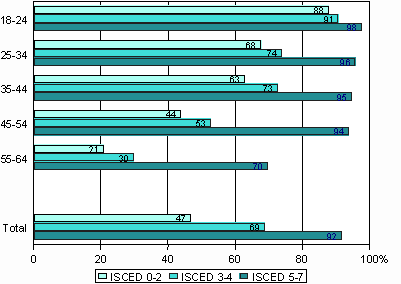
The main ways in which the adults had learned to use a computer were by themselves, through trial and error, and with the help of colleagues, friends or family members.
Four fifths of the adults claimed knowledge of a foreign language
Four out of every five respondents aged 18-64 years claimed at least some knowledge of one or more foreign languages. Almost two thirds mentioned two languages, a third at least three and 13% at least four. The best knowledge was claimed by the young people, the women and those with the highest level of basic education.
Knowledge of foreign languages by number of languages, gender and highest level of educational attainment in 2000 (population aged 18 - 64)
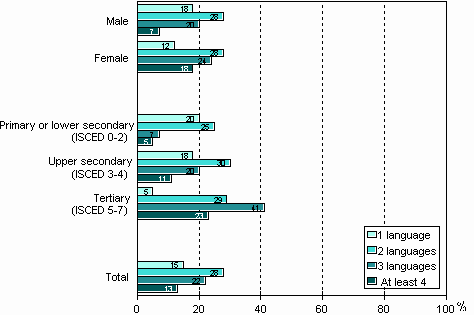
English was the most common foreign language and the best known, with almost three fourths of the adults able to speak it to some extent. The second most common was Swedish and the third German.
A fifth of the respondents stated that they needed teaching in foreign languages, while only 6% had actually received such teaching over the past year and 3% had studied languages by themselves.
About 12% of the population aged 65-79 years participated in adult education
About 12% of the respondents aged 65-79 years said that they had participated in adult education during the last year, with no difference between the men and women. The great majority had attended courses at adult education centres or institutes connected with their own hobbies or interests, the most popular subjects being fine and applied arts and physical education.
The most serious barriers to participation in this age group were health and age problems and lack of interest.
Last updated 2.11.2009
Official Statistics of Finland (OSF):
Participation in adult education [e-publication].
ISSN=2489-6926. 2000,
Main results from the publication "Participation in adult education and training in Finland. Adult Education Survey 2000"
. Helsinki: Statistics Finland [referred: 19.4.2024].
Access method: http://www.stat.fi/til/aku/2000/aku_2000_2004-05-31_kat_001_en.html

